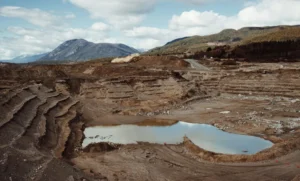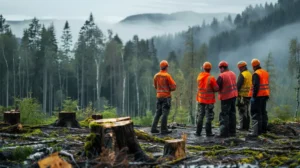A Volcano’s Aftermath
Consider the scene after a volcanic eruption—the land scorched, covered in ash and lava, with jagged rocks as far as the eye can see. The air is thick with dust, and the ground is bare and lifeless. Yet, in the middle of this desolation, small patches of life begin to emerge. This is where nature begins its process to recover.
Ecological Succession in Barren Lands
In such conditions, pioneer species are the first species to thrive and take on a very important role in restoring life. Pioneer species are organisms that can grow in severe, barren conditions. Following an eruption, the ground needs something to break down the rock, start to form soil, and make way for plants and other life forms. Without these pioneers, life would find it difficult to return.
What are Lichens
Lichens are exceptional organisms formed by a mutualistic relationship between a fungus and a photosynthetic partner. They can be found in diverse environments, from deserts to arctic tundra. Lichens are known for their resilience in harsh conditions. They grow on rocks, trees, and other surfaces. They constitute an important part of all ecosystems.
Lichens as Key Pioneers
Lichens are among the best pioneer species. These hardy organisms can occupy bare rock and begin the slow process of rebuilding an ecosystem. Their survival ability in tough conditions makes them very important in the early stages of recovery after a volcanic eruption. They are the foundation upon which future life can grow.
The Role of Lichens as Pioneer Species

The pioneer species are the very first organisms to colonize the barren environment. After volcanic eruptions, the lands are cleared of all life, and then these species come in and lay the groundwork for further ecosystems. They do not need soil to survive, which makes them perfect for rocky, ash-covered landscapes.
Why Lichens are Perfect for the Job
Lichens are a symbiosis of algae and fungi living together. It is that association that allows them to thrive in one of the most unforgiving environments, hence making them a strong candidate to be among the very first to reappear after an eruption. Their presence marks the start of primary succession in places once too barren for life to exist.
How Lichens Thrive on Bare Rock
Colonizing Bare Rock
Lichens can grow directly on rocks without having to begin with soil. That is why they are very suitable for landscapes after a volcanic eruption. Since lichens do not have roots, they get all of their nutrients from rain and air, unlike plants.
The Symbiotic Partnership
Lichens are two organisms combined: algae, which provides food through photosynthesis; and fungi, which protects the algae and helps it absorb water. Together, they manage to survive on bare rock in this symbiotic relationship. They are one of the first organisms to occupy areas that have been devastated by volcanic eruptions because of their adaptability.
Lichens and Soil Formation
Breaking Down Rocks for Soil
Lichens have one of the most vital roles they play in the succession process within the ecosystem; it is to break down the rock to soil. The acids are secreted slowly to dissolve the rock, making it smaller, and as time passes, it forms soil particles that combine with decomposing lichens.
Contributing to Soil with Organic Matter
As lichens grow and die, their decaying matter adds organic material to the newly formed soil. This organic matter helps improve the soil’s quality, making it possible for other plants to eventually take root. Through this process, lichens lay the foundation for a more diverse range of plant life, allowing the next stages of succession, such as secondary succession, to take place.
Nutrient Enrichment Through Nitrogen Fixation
The Nitrogen Fixation Process
Some lichens play an important role in cracking the rock, and simultaneously fertilize soils with nutrients for growing plants. Some lichens fix atmospheric nitrogen, meaning they will transform the nitrogen in the air so it can be used by plants in growing. This is so significant because nitrogen is one of the major nutrients that help growing plants.
How Nitrogen Fixation Supports Future Plant Life
The nutrient quality of the developing soil improves by fixing nitrogen, meaning that lichens contribute to making the land a more fertile environment for plants that will follow in the process of ecological succession. In its absence, future plants would be incapable of growing in the soil left behind after the eruption of a volcano due to its barren and nutrient-poor nature. This nitrogen contribution is one more way through which lichens prepare the land for the return of life.
Microhabitats and Environmental Modification
Creating Conditions for Other Species
The contribution of lichens goes beyond rock fragmentation and soil improvement. They facilitate and establish small, protected environments on the rock surface. Lichens retaining moisture in bare rock make it possible for other tiny organisms to take advantage of the same, thus creating microhabitats where there can be shelter and nutrition.
Making the Environment More Hospitable
With time, these microhabitats affect the conditions on the bare ground that they have covered. Lichens’ ability to offer some sort of moisture and shelter tends to make the surrounding environment favorable to other plants and animals as well. This way, lichens are not just mere survival organisms in a hostile habitat but are actually affecting the surroundings in ways that make them hospitable for species that succeed them.
Facilitating Further Ecological Succession
Paving the Way for Future Plant Growth
Once lichens start to break rock, form soil, and infuse life into it through nutrients, then other plants such as mosses and grasses sprout. Such plants continue to work by the lichens as they continue to strengthen the soil from erosion. Lichens can be a bridge between lifeless rock to a thriving ecosystem.
Initiating the Progression of Succession
Lichens form the foundation for primary succession after an eruption of volcanoes. As they alter the environment, they produce the conditions necessary for the existence of more advanced plant species. Over time, it produces a stable and diverse ecosystem. If lichens were absent, ecological succession would be much slower and even more difficult since they are the pioneers that start changing the landscape.
Conclusion
Lichens are true pioneers after a volcanic eruption. They colonize bare rock, secrete acids to break it down, contribute to soil formation, and improve the land with nutrients through nitrogen fixation. They also create microhabitats that retain moisture, making the environment more hospitable for other organisms. In every way, lichens set the stage for the return of life.
Final Thoughts
The role of lichens as pioneer species is fundamental in rebuilding ecosystems after volcanic eruptions. They transform the barren landscapes into more fertile environments that allow future plants and animals to thrive. In the absence of lichens, ecological recovery would be much slower, and the land would remain desolate for a much longer time.




